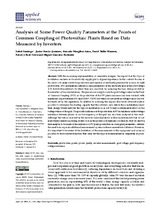Mostrar el registro sencillo del ítem
Analysis of Some Power Quality Parameters at the Points of Common Coupling of Photovoltaic Plants Based on Data Measured by Inverters
| dc.contributor.author | Santiago, Isabel | |
| dc.contributor.author | García‐Quintero, Javier | |
| dc.contributor.author | Mengíbar‐Ariza, Gonzalo | |
| dc.contributor.author | Trillo Montero, David | |
| dc.contributor.author | Real Calvo, Rafael Jesús | |
| dc.contributor.author | González Redondo, Miguel Jesús | |
| dc.date.accessioned | 2022-01-24T11:18:12Z | |
| dc.date.available | 2022-01-24T11:18:12Z | |
| dc.date.issued | 2022 | |
| dc.identifier.uri | http://hdl.handle.net/10396/22369 | |
| dc.description.abstract | With the increasing implementation of renewable energies, the impact that this type of installation can have on the electricity supply grid is of great importance. In this context, the aim of this work is to analyse how the production and injection of electricity generated by a series of small photovoltaic (PV) installations influence some parameters of the electricity grid in the low-voltage (LV) distribution networks to which they are connected, by analysing the basic data provided by the inverters of these installations. The presence of a slight rise in the grid voltage values in the Point of Common Coupling (PCC) as the production of the PV plants increases has been verified, with maximum slopes between 0.95 and 0.00027 V/kW, but which do not result in voltage values close to the limits set by the regulations. In addition to assessing this impact, the results obtained made it possible to determine the hosting capacity that the networks into which these installations inject their energy would have for this type of installation so as not to have a detrimental effect on the voltage values of the grid. The possible influence of the production of PV installations on the voltage imbalance between phases or on the frequency of the grid has also been analysed in this work. Although the values recorded by the inverters have limitations in their measurements that do not make them valid for assessing events such as the presence of harmonics or flickers, they do allow a first analysis to be made of the influence of PV plant production on some grid parameters, without the need to incorporate additional measurement systems in these renewable installations. However, it is important to be aware of the limitations of the measurements of this equipment and, as far as possible, to choose inverter models that carry out this type of measurement as completely as possible. | es_ES |
| dc.format.mimetype | application/pdf | es_ES |
| dc.language.iso | eng | es_ES |
| dc.publisher | MDPI | es_ES |
| dc.rights | https://creativecommons.org/licenses/by/4.0/ | es_ES |
| dc.source | Applied Sciences 12(3), 1138 (2022) | es_ES |
| dc.subject | Photovoltaic plants | es_ES |
| dc.subject | Power quality | es_ES |
| dc.subject | Inverter measurements | es_ES |
| dc.subject | Grid voltage | es_ES |
| dc.subject | Grid frequency | es_ES |
| dc.subject | Voltage imbalance | es_ES |
| dc.title | Analysis of Some Power Quality Parameters at the Points of Common Coupling of Photovoltaic Plants Based on Data Measured by Inverters | es_ES |
| dc.type | info:eu-repo/semantics/article | es_ES |
| dc.relation.publisherversion | https://doi.org/10.3390/app12031138 | es_ES |
| dc.relation.projectID | Gobierno de España. PID2019‐108953RA‐C22 | es_ES |
| dc.rights.accessRights | info:eu-repo/semantics/openAccess | es_ES |

